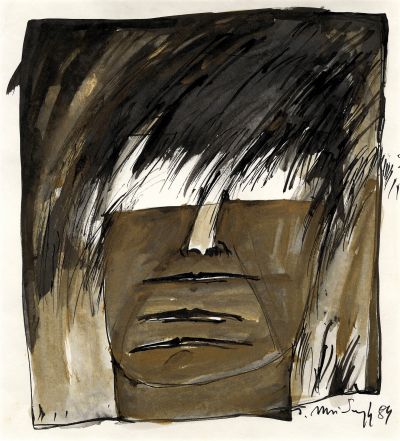Janina Musiałczyk. W drodze, on the road
Mediathek Sorted




































































































Other series from the 1990s and 2000s focus on the fluctuation between different emotional states, as in the drawings from “It Teeters”, between staying and leaving in times of war, destruction and disintegration (Fig. 40, 41), between times in which one loses the ground from under one’s feet (all 1995, Fig. 54, 59), a final scream (1996, Fig. 44) and situations in which one becomes entangled in contradictory feelings (2000/01, Fig. 31, 30). The series “From Here to There” (Von hier bis dort) (1996, Fig. 56, 57), “On the Road” (Unterwegs) (1996-98, Fig. 5, 6, 63), “Journeys” (Auf Reisen) (2000, Fig. 61) and “Together” (Zusammen) (2000, Fig. 27–29) show the walking figures alone, in groups and as couples, crammed into narrow spaces, entwined or in a fight against each other. During their “departure”, they flee in the “ornament of the mass” (Siegfried Kracauer) or in a never-ending confrontation with obstacles (2000, Fig. 17, 45–49, 85).
In her series, which she produced from 1981 onwards, Musiałczyk reflects her own experience in drawn and painted parables, which attain universal relevance through the stylistic techniques of New Figuration, as well as through references to literature, mythology, and art history. High compositional, graphic and colouristic quality create a narrative plane that enables the image scenes to be read beyond their biographical origins – such as when the artist restricts the movement of the figures using the confines of the paper format (Fig. 53), creates drama through chaotic strokes of the pen (Fig. 40), or using a particular type of sfumato technique, characterises interrelationships among the figures or between the figures and the outside world (Fig. 28).
In 1998, Wojciech Leder referred to this universal plane in his essay: “The works by my teacher are an expression of an unusually subjective truth, which is, however, shared by many people. [...] These pictures are a lonely way of handling [...] time, which is dominated by a longing for past places, past people [...]. [...] The intimacy and sincerity seeps through from sensitivity to sensitivity – almost a tender whisper”.[69] The Polish writer and essayist Janusz Rudnicki, who has lived in Hamburg since 1983, was reminded of his own experiences: “Something made me stop and think with your works, however. The central train station in the 1960s, I was ten years old, after 3 o’clock in the afternoon, day after day. I am waiting for the train, for mother, like I did every day, she came by train from work. A stream of cloned, grey, hunched people flows out of the train. As though they had just exited from a cave. From the cave to home, their daily march. Not going towards anything, just around in a circle. [...] It tormented me: where have I seen these human-like figures before? [...] Do you know what it is? Chromosomes. [...] Cyclical transformations, long chains, don’t you feel at home there?”[70]
Musiałczyk has an affinity with Polish poster art, which from the 1950s onwards was also visible in exhibitions and publications in the Federal Republic of Germany, and which has also been on display in public and private collections since that time.[71] During the early post-war period, Polish artists developed a new aesthetic for film, theatre, opera, and exhibition posters. Here, in contrast to Hollywood posters, the themes were not directly transferred into imagery, but were encoded in abstract or expressive symbols and figures.[72] While during the 1960s and towards the beginning of the 1970s, coloured designs with doll-like motifs were predominant, the pictorial world became darker towards the end of the 1970s and during the 1980s and 1990s. Now, the designs were dominated by immobile faces and destroyed physiognomies. Faces pressed into boxes, like those we find in Musiałczyk’s drawings and paintings, are also depicted in posters by Wiktor Sadowski, while bandaged and fully bound physiognomies can be seen in the work of Andrzej Pągowski. The screaming, unlocked mouth from Musiałczyk’s series “It Teeters” (Es taumelt) (1996, Fig. 44), which is of course also recognisable as the motif by Munch, was also used previously by Krzysztof Bednarski, Wiesław Wałkuski, and Pągowski. Conversely, among numerous artists such as Stasys Eidrigevičius, Jerzy Czerniawski, Sadowski, Leszek Żebrowski and Mieczysław Górowski, the separated, immobile faces from Musiałczyk’s “Seeing Stones” (Schauende Steine) series became a real standard motif from 1985 until into the 2000s.[73]
However, Musiałczyk’s figural scenes are not just full of melancholy and sadness, as is often claimed.[74] Her figures allow us to get close, and rather than being permanently separated through conflicts and fighting, are eternally connected to each other. Individual figures emerge from the mass and go their own way. “I look at your small drawings and suddenly see”, Piotr eL wrote from Częstochowa in 1998, “that here there is also something new that gives reassurance”.[75]
[69] See note 43.
[70] Janusz Rudnicki to Janina Musiałczyk in connection with the New Drawings (Neue Zeichnungen) exhibition in Pro Linguis Kulturforum, Hamburg, January 2001.
[71] See also Regina Wenninger on this portal: Polish poster art in post-war Germany (2017), https://www.porta-polonica.de/en/atlas-of-remembrance-places/polish-poster-art-post-war-germany?page=1#body-top.
[72] See also Axel Feuß on this portal: The collectors Joanna and Mariusz Bednarski talk about Polish poster art, https://www.porta-polonica.de/en/atlas-of-remembrance-places/collectors-joanna-and-mariusz-bednarski-talk-about-polish-poster-art, particularly page 3.
[73] The enormous collection of Polish posters owned by Mariusz Bednarski (Berlin) can be found at his online shop, Pigasus Polish Poster Shop, https://polishpostershop.com/poster/polnische-filmplakate.html (last accessed on 25.10.2023).
[74] “In some images, Janina Musialczyk creates a disconcerting melancholy, while others are poetic in a sad way, sometimes oppressive”. (Larissa Wasserziehr 2019, see note 34). – “The physiognomy cannot be precisely interpreted, but it tends towards sadness or melancholy”. (Patrick Schmidt, opening speech for the exhibition “Pen Strokes for Today, Layers of Colour for Yesterday” (Federstriche für heute, Farbschichten für gestern. Janina Musiałczyk, Zeichnungen und Bilder), Künstlerhaus Bergedorf, Hamburg 1998).
[75] Piotr eL to Janina Musiałczyk, 17.11.1994.





















































































